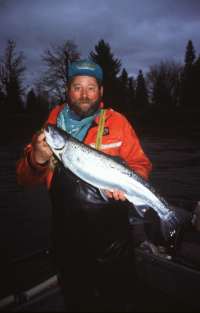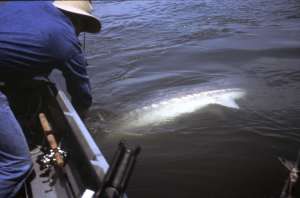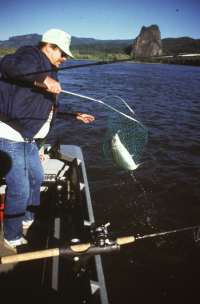The Columbia River, as it cuts through the Pacific Northwest ofAmerica, is one of the county’s most significant rivers, and one ofits most diverse fisheries.
It is both soothing and undeniably eerie to wade out into theColumbia River at dusk. The three quarters of a mile immediately infront of you looks like a great rose-colored plain in the dimminglight. But fix your eye on an object in the distance–a drowning bushor the tip of a float–and the whole of your foreground sprints awayfrom you. A good-sized fishing boat, one that would comfortablyhandle a sea fishing charter in British waters, motors slowlyupstream, then cuts its engine and is immediately swiped down river.It’s the quiet that’s most impressive though. Several hundredthousand cubic feet per second of water is pulling at your boots,trying to drag you to the Pacific, and it makes no more noise than apiston sliding in its housing.
|
|
| |
The Columbia River begins at Columbia Lake in British Columbia andjourneys 1200 miles until it empties into the Pacific Ocean atAstoria on the Oregon coast. At various points it is more than a milewide and a hundred feet deep. Despite its impressive measurements theColumbia is also one of the world’s most “at-heel” river systems.There are 79 dams along its length, built either to generatehydroelectric power, for flood control, or as job creationenterprises during the Depression. The dams have largely flattenedthe great salmon and steelhead runs that once swarmed the river. Thesalmon and steelhead fishery on the Columbia is now very heavilydependent on hatcheries.
How to resuscitate wild salmon and steelhead in the Northwest, andthe Columbia runs in particular, is at the eye of a bitterenvironmental and political storm here, with billions of dollarsspent and little traceable improvement to the wild fishery.
The Columbia endures, however, with widely varying returns of bothhatchery and wild salmon and steelhead, and an increasingly famouswarm water fishery. In the most heavily dammed portions of theColumbia the river is now, in effect, a chain of lakes orimpoundments. The reduced flow, warmer water, and abundant foragehas, in turn, nurtured species such as smallmouth bass and walleye tonear record proportions. Allied to a world-class white sturgeonfishery, a biblical-sized run of shad, and totally unexplored carppotential, and the Columbia still contends as one of America’sdestination fisheries. Oh, and at certain times of the year, thegovernment will pay you to fish it. More on this later.
Unless you have local connections or a lot of time to spend, aguide is a practical necessity on this huge river (see contactinformation at the end of this article). Served by an internationalairport and straightforward access from Seattle or San Francisco, oneof America’s most attractive cities, Portland, Oregon, is a shortdrive away from some of the best fishing on the river. It’s quitepossible to tie into a 200 or 300 pound sturgeon, and be toasting itscapture in a lively downtown bar within an hour.
What follows is a list of the major fisheries on the Columbia asit marks the boundary between Oregon and Washington, all easilyaccessed from Portland.
Salmon
The Columbia was once home to colossal returns of wild Chinook,coho and sockeye. The fishing is now constantly regulated to protectdiminished runs of wild fish, but there is still good to very goodfishing for hatchery coho and Chinook. The 2001 spring Chinook run,for example, was record-breaking, and the summer coho return to theColumbia is also expected to be huge this year–more than a millionfish.
Spring Chinook generally enter the river in mid February; FallChinook opens around the beginning of August. Summer coho areavailable from late June.
|
|
| and one happy angler |
Because of wildly varying runs and the evolving nature ofregulations on the river (they can literally change overnight), it’sessential to stay updated on the fishery if you’re planning a trip.The web sites listed at the end of the article should be able to keepyou informed.
Steelhead
Both winter-run and summer-run steelhead can be caught from themain stem Columbia. Winter fish move up from the lower river Novemberthrough March, and summer-runs can be caught from the middle of Maythrough August, depending on what section of the river you’re on.Summer-runs are the most popular–in part because the Columbia can besuch a harsh, wind-scoured place in the winter.
Run sizes and regulations for Columbia steelhead are similarlyelastic, so again, it pays to plan ahead.
Sturgeon
The Columbia has one of the healthiest populations of whitesturgeon anywhere in the world. They can be fished for year roundfrom the coastal estuary to 130 miles upstream at Bonneville Dam. Thereally huge fish (more than 10-feet long and 700lbs) are spawningfemales that concentrate below Bonneville in May and June.
|
|
| to be unhooked |
Walleye
The Columbia has a national reputation for trophy walleye, cousinto the European zander. They have been caught to nearly twenty poundsin the impoundments above Bonneville. Smaller fish can be caughtFebruary through late autumn, all the way down river to Portland.Jigs tipped with worms and just barely worked off bottom (to imitatesmall emerging lampreys) is one popular method. Serious walleyehunters use sonar and navigation maps to home in on submergedstructure and precise depth preferences. Though U.K. anglers aren’treally accustomed to “harvesting” their catch, deep-fried, batteredwalleye fillets are considered to be a shore lunch without equal inthe U.S.
Bass and Panfish
Often overshadowed by the bigger gamefish in the river, bass andpanfish are abundant throughout the Columbia. Smallmouth bass are themost sought after among these second-tier species and they grow to avery respectable 6-pounds-plus in the lake-like sections aboveBonneville dam. Professional bass fishing tournaments are a fixtureon certain parts of the river, and they’ve produced catches on a parwith anywhere in the country.
Panfish is the collective name for a host of smaller (pan-sized)species. In the Columbia it includes bluegills, yellow perch,crappie, channel catfish, brown bullheads, and others. Like thesmallmouth, fishing for these species is often concentrated aroundavailable structure or features such as pilings, rocky embankments,docks, bridge supports, log rafts, and submerged trees and bushes. Marshy backwaters, channels, and ponds off the main river are alsohotspots. Favorite methods are light-tackle jigging, and floatfishing with worms and other bait.
Shad
|
|
| in the annual party |
There is a very substantial annual shad migration up the Columbia,with fish moving through the lower river in about mid-May. It isn’tunusual for the run to exceed 2,000,000 fish, and anglers, walleye,and sturgeon all share in the bounty, before these sporting, silveryfish move up river. The record for the Columbia is 5lbs 12oz.
Carp
I’m tempted to just type a series of italicized question marks forthis entry. The carp potential here is completely unexplored. Noquestion, there are plenty in there (but that could be said for justabout every body of water in the country). The Columbia growseverything else to huge proportions: carp would be no different. What’s huge? It’s difficult to track down reliable reports, but Iknow one very experienced angler who told me about a remote bay he’dcome across while steelhead fishing. He noticed some large fishrooting around on a broad shallow flat. He anchored up, and what hesaw over the next hour was about a dozen 35- to 40-pound commonsghost-up from a drop off and start digging out crayfish from thebottom of the flat. The Columbia is stiff with crayfish (or crawfishas they’re called in the U.S.), and their presence is often adetermining factor in the growth of really monster carp.
One of those perfect, wild bulls plunging into the Columbia’s hugeflows could be the highlight of a carping career.
Pikeminnow
Pikeminnow? Don’t laugh, it could make you some serious money.Since 1991, in what is America’s only bounty program for a fish(bounties are sometimes offered to cull over-populated or nuisanceanimals), Columbia River pikeminnows have a price on their headbecause of their heavy predation on salmon smolts. Anglers are paidbetween $4 and $6 for every fish over 9 inches they catch and turn into checkpoints along the river. Program coordinators claim that thebounty-fishery has resulted in a 25% decline in salmon snacks for theovergrown wide-mouthed minnows over the course of the 10-year study.The season opens in April but the best time of year is mid-Junethrough the end of September. The top moneymaker on the river lastyear, fishing with a single rod and reel (no nets allowed) made–waitfor it–$45, 534. That’s about 30,000 quid. Not bad for snatchingminnows.
Contacts
Clancy’s Guided Sportfishing 1-800-871-9549
Terry Johnson 1-800-831-4107
Bite-Me Guide Service 503-463-0719
All photographs by Nick Amato
















